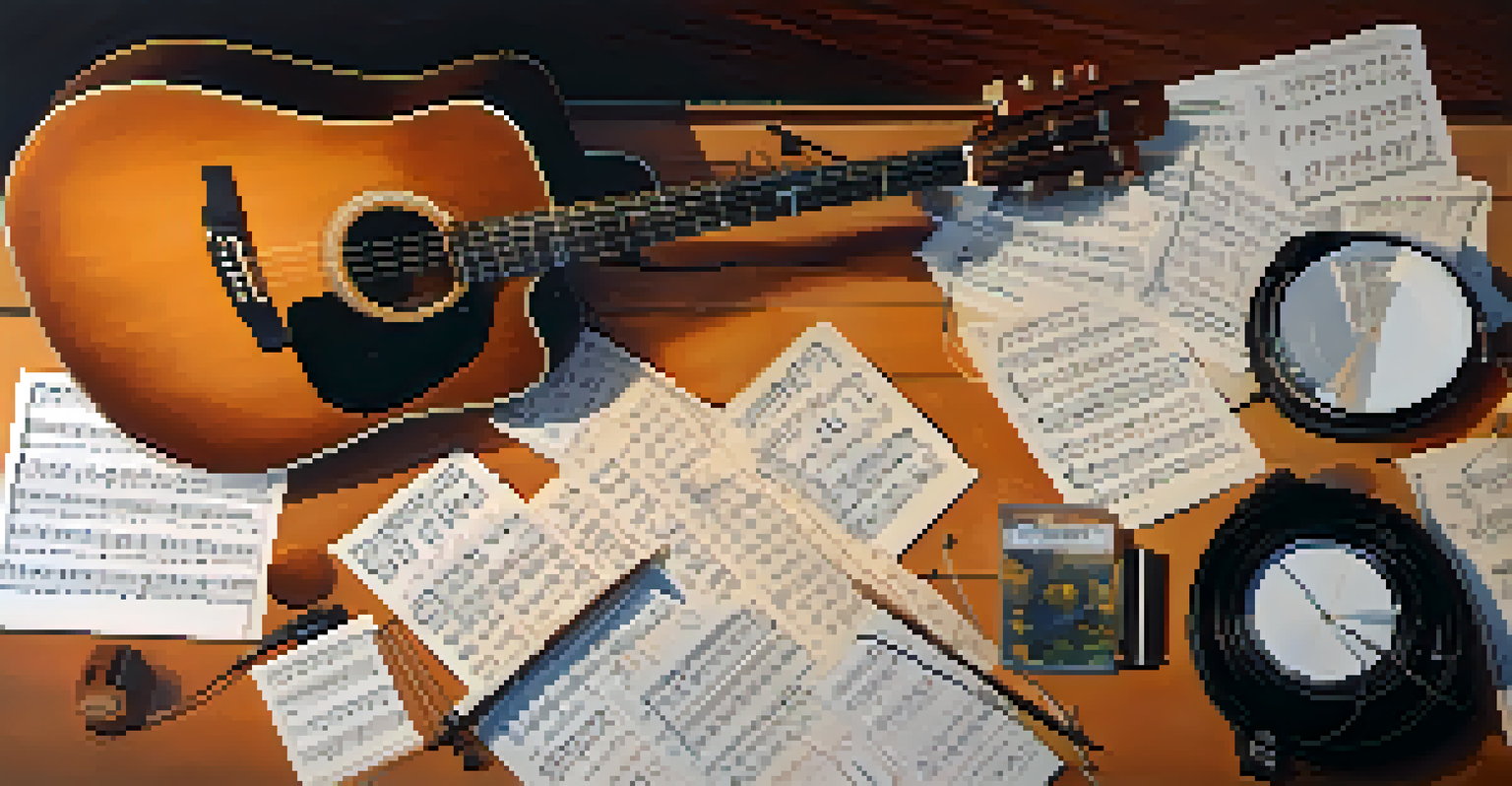Understanding Chord Voicings for Vocal Performance on Guitar

What Are Chord Voicings and Why Do They Matter?
Chord voicings refer to the different ways you can play a chord on the guitar. Essentially, it’s about the arrangement of notes within that chord. This is crucial for vocal performance because the right voicing can complement a singer's range and enhance the overall sound of the music.
Music can change the world because it can change people.
Imagine you’re baking a cake; the ingredients can be mixed in various ways to change the flavor. Similarly, changing the voicing of a chord can drastically alter the mood and texture of a song. For example, a major chord played in a higher voicing can sound bright and uplifting, while the same chord in a lower voicing may feel more grounded.
Understanding chord voicings allows you to create a more dynamic and engaging accompaniment for vocalists. It can help you support their performance without overpowering them, making the entire musical experience richer.
Basic Chord Voicings: Major and Minor
At the heart of chord voicings are the basic major and minor chords. A major chord has a happy, bright sound, while a minor chord introduces a more somber, introspective tone. Knowing how to play these chords in various voicings is essential for any guitarist working with vocalists.

For example, a C major chord can be played in several positions on the guitar neck, each offering a different sound texture. Similarly, an A minor chord can be voiced differently to suit the singer's vocal line better. By experimenting with these variations, you’ll find the best fit for the song's mood.
Importance of Chord Voicings
Chord voicings enhance vocal performances by complementing a singer's range and enriching the overall sound.
These basic voicings form the foundation of many songs, so mastering them can significantly enhance your playing. As you grow more comfortable, you’ll discover how to weave these voicings into your accompaniment seamlessly.
Exploring Extended Chord Voicings
Extended chord voicings include additional notes beyond the basic triads, such as sevenths, ninths, and even thirteenths. These extra notes can add depth and complexity to your guitar playing, making your accompaniment more interesting. For vocalists, these voicings can evoke a wider range of emotions.
The beautiful thing about learning is that no one can take it away from you.
Think of extended chords like adding toppings to a pizza. A basic cheese pizza is tasty, but adding pepperoni and veggies takes it to another level. Similarly, a Cmaj7 chord adds a subtle richness compared to a standard C major chord, which can beautifully enhance the singer’s performance.
By incorporating these extended voicings, you can create a more colorful harmonic backdrop for vocalists. This not only supports their melodies but also allows for more expressive interpretations of the song.
Utilizing Open and Closed Voicings
Open voicings use wider intervals between the notes, while closed voicings group notes closer together. Open voicings tend to sound more spacious and airy, which can be great for folk or pop songs. Closed voicings, on the other hand, can create a more compact and intense sound.
Consider a garden: an open voicing is like a sprawling wildflower garden, while a closed voicing resembles a neatly trimmed hedge. Each has its charm and can attract different kinds of attention. This choice can significantly influence how a vocalist feels while performing.
Master Major and Minor Voicings
Familiarity with major and minor chord voicings is essential for guitarists to create dynamic and engaging accompaniment.
By mastering both open and closed voicings, you can adapt your accompaniment to match the style and emotion of the song. This versatility is key to providing the best support for vocal performances.
The Role of Inversions in Chord Voicings
Chord inversions occur when the notes of a chord are rearranged so that a different note is the lowest. This can dramatically change the sound and feel of the chord, allowing you to create smoother transitions between chords. Inversions are particularly useful for maintaining a consistent bass line while accompanying a singer.
Imagine driving on a winding road. Sometimes you take a turn that leads you to a stunning view. Similarly, using inversions can lead your music in unexpected and beautiful directions. A G major chord in root position sounds different from a G major chord in first inversion, which can be more pleasing to the ear.
Incorporating inversions into your chord voicings not only enriches your playing but also makes your accompaniment more fluid. This can lead to a more enjoyable experience for both you and the vocalist.
Applying Chord Voicings to Different Genres
Different musical genres often call for different chord voicings. For example, jazz tends to utilize more complex and extended voicings, while folk music might lean towards simpler, open voicings. Understanding these nuances can help you tailor your playing to fit the style of the song and the preferences of the vocalist.
Think of it as dressing for an occasion: you wouldn’t wear a tuxedo to a beach party. Similarly, the voicings you choose should match the genre’s vibe. A jazz standard might shine with rich, extended chords, while a country tune could resonate better with straightforward major and minor voicings.
Genre-Specific Voicing Techniques
Understanding how different genres utilize various chord voicings allows musicians to tailor their playing to fit the style and enhance vocal performances.
Being flexible with your voicings allows you to adapt your playing to various genres and artists, making you a more versatile guitarist. This adaptability is essential for enhancing vocal performances across different musical landscapes.
Practicing Chord Voicings for Vocal Performance
To effectively use chord voicings in vocal performance, practice is key. Start by identifying the song you want to accompany and analyze its chord structure. Experiment with different voicings and see how they interact with the vocal line. This hands-on approach will help solidify your understanding.
Consider setting aside time each week to focus solely on chord voicings. You might even record yourself to hear how different voicings sound in context. This can be a game-changer, allowing you to make adjustments and find the best fit for your accompaniment.

Ultimately, practice is about exploration and discovery. The more you play with different voicings, the more intuitive your choices will become, leading to a richer experience for both you and the vocalist.